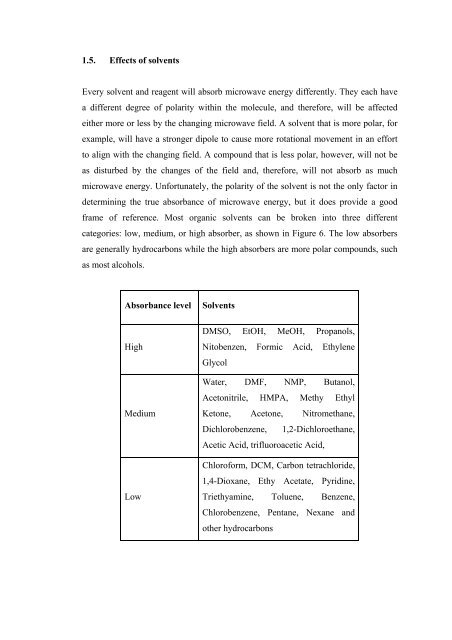Download (8Mb) - Etheses - Saurashtra University
Download (8Mb) - Etheses - Saurashtra University
Download (8Mb) - Etheses - Saurashtra University
Create successful ePaper yourself
Turn your PDF publications into a flip-book with our unique Google optimized e-Paper software.
1.5. Effects of solvents<br />
Every solvent and reagent will absorb microwave energy differently. They each have<br />
a different degree of polarity within the molecule, and therefore, will be affected<br />
either more or less by the changing microwave field. A solvent that is more polar, for<br />
example, will have a stronger dipole to cause more rotational movement in an effort<br />
to align with the changing field. A compound that is less polar, however, will not be<br />
as disturbed by the changes of the field and, therefore, will not absorb as much<br />
microwave energy. Unfortunately, the polarity of the solvent is not the only factor in<br />
determining the true absorbance of microwave energy, but it does provide a good<br />
frame of reference. Most organic solvents can be broken into three different<br />
categories: low, medium, or high absorber, as shown in Figure 6. The low absorbers<br />
are generally hydrocarbons while the high absorbers are more polar compounds, such<br />
as most alcohols.<br />
Absorbance level Solvents<br />
High<br />
Medium<br />
Low<br />
DMSO, EtOH, MeOH, Propanols,<br />
Nitobenzen,<br />
Glycol<br />
Formic Acid, Ethylene<br />
Water, DMF, NMP, Butanol,<br />
Acetonitrile, HMPA, Methy Ethyl<br />
Ketone, Acetone, Nitromethane,<br />
Dichlorobenzene, 1,2-Dichloroethane,<br />
Acetic Acid, trifluoroacetic Acid,<br />
Chloroform, DCM, Carbon tetrachloride,<br />
1,4-Dioxane, Ethy Acetate, Pyridine,<br />
Triethyamine, Toluene, Benzene,<br />
Chlorobenzene, Pentane, Nexane and<br />
other hydrocarbons

















